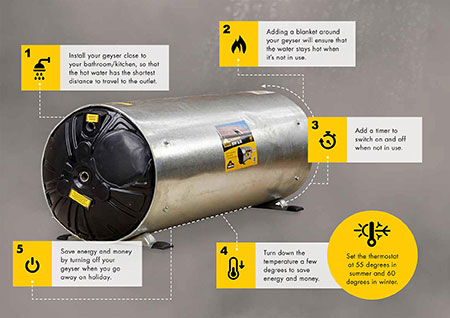Geyser Tips
In an average household, the geyser is the most energy-consuming appliance - taking up almost 40 percent of your monthly electrical bill. Here are some tips on getting the most out of your geyser.
31/10/2017
Keep energy costs down
The first step in keeping energy costs down is to choose the right geyser for the size of your family. To do this, work out how much hot water you use in a single day. For example, it takes 25 litres per person to shower and 35 litres per person to fill a bath. If you’re washing dishes by hand, you’ll use 5 litres, while a machine wash will take 34 litres; a washing machine uses 50 litres. Using these figures as a rough guide, a family of four would use over 120 litres of water a day. To make sure nobody ends up having a cold shower, you’ll need the right sized geyser.
Geysers start at a capacity of 50 litres, increasing in 50-litre increments up to 250 litres. All geysers are high-pressure systems - the standard here in South Africa - and can be installed either vertically or horizontally.
Installing a geyser
Once you have calculated the right geyser to meet the needs of your family, it needs to be installed. Don't install a geyser yourself - have it installed by a certified professional. Every geyser must meet certain legal quality standards, so if something goes wrong and you’ve installed your geyser yourself, it will affect your guarantee and even your insurance claim if there’s damage to your home. You will also need an electrician to earth the geyser and the metal pipes.
Set the right temperature
Eskom recommends setting the temperature on your geyser thermostat according to the seasons. During the summer months, a temperature setting from 70°C to 60°C will achieve a saving of 18 kWh (about 5%). Ideally, your geyser should be set between 55 °C and 65°C, depending on the season.
Replacing a thermostat
A geyser and all component parts must comply with SANS 10254 installation specifications, so any and all repairs or replacements must be done by a certified plumber. An unqualified supplier, or someone using the incorrect parts, could void the guarantee on the geyser. Or worse, your insurance company may refuse to pay out if your geyser isn’t up to code, malfunctions or causes serious water damage to your home.




